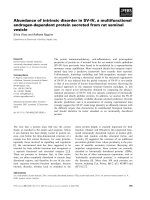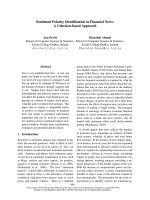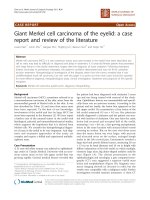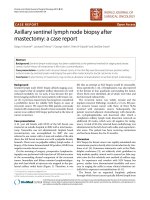Báo cáo khoa hoc:" Whole body bone scintigraphy in osseous hydatosis: a case report" pps
Bạn đang xem bản rút gọn của tài liệu. Xem và tải ngay bản đầy đủ của tài liệu tại đây (299.83 KB, 4 trang )
BioMed Central
Page 1 of 4
(page number not for citation purposes)
Journal of Medical Case Reports
Open Access
Case report
Whole body bone scintigraphy in osseous hydatosis: a case report
Abdolali Ebrahimi
1
, Majid Assadi*
1
, Mohsen Saghari
2
,
Mohammad Eftekhari
2
, Amir Gholami
2
, Reza Ghasemikhah
3
and
Sakineh Assadi
1
Address:
1
Department of Oncology and Nuclear Medicine, The Persian Gulf Health Research Center, Bushehr University of Medical Sciences,
Bushehr, Iran,
2
Research Institute for Nuclear Medicine, Shariati Hospital, Tehran University of Medical Sciences, Tehran, Iran and
3
Department
of Parasitology, Faculty of Health Sciences, Tehran University of Medical Sciences, Tehran, Iran
Email: Abdolali Ebrahimi - ; Majid Assadi* - ;
Mohsen Saghari - ; Mohammad Eftekhari - ; Amir Gholami - ;
Reza Ghasemikhah - ; Sakineh Assadi -
* Corresponding author
Abstract
Hydatid disease is common in many parts of the world, and causes considerable health and
economic loss. This disease may develop in almost any part of the body.
Bone involvement is often asymptomatic, and its diagnosis is primarily based on radiographic
findings. A whole body bone scan is able to show the extent and distribution of lesions.
We describe an unusual case of multifocal skeletal hydatosis and also explain the clinical and
diagnostic points. We hope to stimulate a high index of suspicion among clinicians to facilitate early
diagnosis and to consider this disease as a differential diagnosis in cases of multiple abnormal activity
in bone scintigraphy especially among people in endemic areas.
Background
Echinococcosis is a zoonotic infection caused by adult or
larval (metacestode) stages of cestodes belonging to the
genus Echinococcus and the family Taeniidae. The adult
Echinococcus lives in the small intestine of carnivores
such as dogs, wolves, jackals and the excreted eggs of the
worm are scattered through the stool of these animals
(Schantz, 1991; Thompson, 1995). Echinococcus granu-
losus has a worldwide geographic distribution and occurs
in all continents including circumpolar, temperate, sub-
tropical and tropical zones [1]. The highest prevalence of
the parasite is found in parts of Eurasia, Africa, Australia
and South America (Figure 1). Within endemic zones, the
prevalence of the parasite varies from sporadic to high,
but only a few countries can be regarded as being free of
E. granulosus (Figure 1).
Hydatid disease may develop in almost any part of the
body. Most hydatid cysts occur in the liver (59–75%), or
in the lung (27%). Involvement of the kidney (3%) or
brain (1–2%) is rare [2].
Bone localization is also rare comprising 0.5% to 2.5% of
all human hydatidosis [3]. The diagnosis of osseous
hydatidosis is primarily based on radiological findings.
Treatment is difficult and recurrence is common [4].
Therefore, plain radiography, CT scan, and MR imaging
are helpful in diagnosing skeletal cystic echinococcosis
Published: 19 September 2007
Journal of Medical Case Reports 2007, 1:93 doi:10.1186/1752-1947-1-93
Received: 29 May 2007
Accepted: 19 September 2007
This article is available from: />© 2007 Ebrahimi et al; licensee BioMed Central Ltd.
This is an Open Access article distributed under the terms of the Creative Commons Attribution License ( />),
which permits unrestricted use, distribution, and reproduction in any medium, provided the original work is properly cited.
Journal of Medical Case Reports 2007, 1:93 />Page 2 of 4
(page number not for citation purposes)
[5]. Osseous foci may manifest as bone pain and deform-
ity, particularly among patients in the 30–60 year olds age
group [6,7]. Hereby, we present an unusual case of multi-
focal skeletal hydatosis and also explain the clinical and
diagnostic points to facilitate early diagnosis of this con-
dition.
Case presentation
The patient was a 53 year old man with a history of
osseous hydatosis since the age of 30. He had had three
surgical operations due to the disease. He had low back
pain and radicular pain in both legs which had been
aggravated over the past month. His past history for any
other illnesses was negative. There wasn't a history of
coughing or other respiratory symptoms. His general con-
dition was good. On examination we detected low back
tenderness in the lumbar area. He had a painful tumor-
like mass in the right hemipelvis which was slightly warm
without overlying erythema. Straight leg raising test (SLR)
was positive in both legs. He had motor and sensory defi-
cit, muscular atrophy and gate disturbance. No other
abnormal findings were detected.
Simple x-ray of the right femur showed advanced lytic
bone destruction, centered in the proximal two thirds of
the right femur. In addition there were the appearances of
nailing due to previous surgery (fig. 2). The plain pelvic x-
ray also revealed marked lytic and sclerotic lesions involv-
ing the right hemipelvis (Figure 3). A whole body bone
scintigram revealed multiple foci of increased radiotracer
uptake in the lower lumbar spine, left sacroiliac region
and right knee. In addition, there was soft tissue bulging
in the right hemipelvis as well as a displaced and discon-
figured right femur (Figure 4). Chest x ray was normal.
Approximate geographic distribution of Echinococcus granulosus [15]Figure 1
Approximate geographic distribution of Echinococcus granulosus [15].
Journal of Medical Case Reports 2007, 1:93 />Page 3 of 4
(page number not for citation purposes)
Conclusion
Hydatidosis is a common disease of both humans and
animals resulting from infection with the larval stage of
the Echinococcus granulosus tapeworm. This disease is com-
mon in many parts of the world and causes considerable
health and economic loss [8].
Liver and lungs are the most commonly involved organs
and involvement of bone and muscles is uncommon [9].
The prevalence of bone infection is 1.1% in nonendemic
to 4% in endemic areas [10]. In descending order, the ver-
tebrae, long bone epiphyses, pelvis, skull and ribs are
most frequently affected. Soft tissue involvement with cal-
cification is highly suggestive of this disease [11].
Men are involved more than women [9] and the peak age
of disease is 21–40 years [10]. Patients with spinal col-
umn hydatid cyst may experience lumbar pain, paresthe-
sia, paraparesia and even paraplegia or sphincter
dysfunction. Neurological symptoms of this disease may
be due to spinal involvement and compression effects on
the spinal cord, or direct cord involvement [10].
Although the incidence of hydatid disease has decreased
as a result of education and control measures, there are
still foci of concern in South America and sporadic cases
still occur in the United States, Europe, the Middle East,
and Asia [12]. Hydatid cysts may lie dormant in the bone
for as long as 40 years and most skeletal hydatid cysts have
been detected in adults. Skeletal cystic echinococcosis
lesions may be single or multiple [5].
A lucent expansile lesion with cortical thinning is the
most frequent radiological pattern, and pathological frac-
tures are common [7].
As hydatid disease of bone remains asymptomatic over a
long period, it is usually detected after a pathological frac-
ture or secondary infection or following the onset of com-
pressive myelopathy in the case of vertebral lesions [7].
The differential diagnosis of skeletal cystic echinococcosis
includes other infectious lesions (e.g. tuberculosis),
fibrous dysplasia and tumors (including simple bone cyst,
aneurismal bone cyst, plasmocytoma, osteosarcoma,
chondorsarcoma, chondromyxoid fibroma, lymphoma,
giant cell tumors, brown tumor and metastases). Diagno-
sis is primarily based on findings of X-ray and CT scans
[5,7]. Whole body bone scintigraphy (WBBS) is able to
show the extent and distribution of lesions. WBBS has a
high sensitivity but has a poor specificity for osteopatho-
logical lesions.
Immunodiagnostic procedures for serum antibody detec-
tion such as enzyme-linked immunosorbent assay (IgG-
ELISA), the indirect hemagglutination antibody test
(IHAT), the latex agglutination test (LAT), the immun-
ofluorescence antibody test (IFAT), immunoelectrophore-
sis (IEP) and some other tests are used for the etiological
confirmation of imaging structures suggestive for cystic
echinococcosis or for diagnosis or differential diagnosis in
cases of uncharacteristic imaging findings [13].
The initial location of the lesion in long bones is meta-
physeal or epiphyseal, later extending to the diaphysis.
Plain x ray of the pelvis revealed marked lytic and sclerotic lesions involving the right hemipelvisFigure 3
Plain x ray of the pelvis revealed marked lytic and sclerotic
lesions involving the right hemipelvis.
Plain x-ray of right femur showed advanced lytic destruction of bone, centered at the proximal two thirds of the right femurFigure 2
Plain x-ray of right femur showed advanced lytic destruction
of bone, centered at the proximal two thirds of the right
femur. There is also a nailing due to previous surgery.
Journal of Medical Case Reports 2007, 1:93 />Page 4 of 4
(page number not for citation purposes)
Potential complications include pathological fracture,
infection, and fistulisation of the abscess [7].
Surgery is the treatment of choice for hydatid bone
lesions. Many authors have advocated wide resection of
the involved bone along with the surrounding soft tissue
as the only definitive treatment of the condition, with or
without chemotherapy using albendazole or mebenda-
zole [14].
Growth in the direction of least resistance, in time, causes
cortical destruction with extension of the cyst into sur-
rounding soft tissues. This condition is rarely encountered
in childhood [7]. Hydatid bone disease should be consid-
ered in the differential diagnosis of osteolytic lesions,
especially in endemic areas. The presence of a periosteal
reaction, osteosclerosis, and calcification are not specific
for hydatid bone disease [7].
Finally, hydatid bone disease should be considered in the
differential diagnosis of osteolytic lesions in radiological
imaging as well as single or multiple abnormal uptakes in
the whole body bone scan especially among people living
in endemic areas.
Abbreviations
ELISA = enzyme-linked immunosorbent assay; IEP =
immunoelectrophoresis; IFAT = immunofluorescence
antibody test; IHAT = indirect hemagglutination antibody
test; LAT = latex agglutination test; SLR = Straight leg rais-
ing test; WBBS = Whole body bone scintigraphy.
Competing interests
The author(s) declare that they have no competing inter-
ests.
Authors' contributions
AE revised the article for intellectual content details and
helped to draft the manuscript .MA participated in writing
of the manuscript and interpretation of the scintigraphic
figures. MS, ME, AG, RG, SA, supervised the acquisition
process and interpreted the scintigraphic and radiological
images. All authors read and approved the final manu-
script.
Consent
Written informed consent was obtained from the patient
for publication of this case report.
Acknowledgements
We are indebted to the technologists at our department for data acquisi-
tion and other technical support.
References
1. Craig PS, Rogan MT, Allan JC: Detection, screening and commu-
nity epidemiology of taeniid cestode zoonoses: cystic echino-
coccosis, alveolar echinococcosis and neurocysticercosis. Adv
Parasitol 1996, 38:169-250.
2. Beggs I: The radiology of hydatid disease. AJR 1985,
145:639-648.
3. Sapkas GS, Stathakopoulos DP, Babis GC, Tsarouchas JK: Hydatid
disease of bones and joints. 8 cases followed for 4–16 years.
Acta Orthop Scand 1998, 69:89-94.
4. Kalinova K, Proichev V, Stefanova P, Tokmakova K, Poriazova E:
Hydatid bone disease: a case report and review of the litera-
ture. Journal of Orthopaedic Surgery 2005, 13:323-325.
5. Merkle EM, Schulte M, Vogel J, Tomczak R, Rieber A, Kern P, Goerich
J, Brambs HJ, Sokiranski R: Musculoskeletal involvement in
cystic echinococcosis: report of eight cases and review of the
literature. Am J Roentgenol 1997, 168:1531-1534.
6. Tüzün M, Hekimoglu B: CT findings in skeletal cystic echinococ-
cosis. Acta Radiology 2002, 43:533.
7. Morris B, Madiwale C, Gary A, Chavhan G: Case report: Hydatid
disease of bone. Australasian Radiology 2002, 46:431.
8. Dalimia A, Ghasemikhah R, Hashemi Malayeri B: Echinococcus
granulosus: lethal effect of low voltage direct electric cur-
rent on hydatid cyst protoscoleces. Experimental Parasitology
2005, 109:237-240.
9. King C: Cestodes (tapeworms). In Principles and practices of infec-
tious diseases 5th edition. Edited by: Mandell G, Bennett J, Dolin R.
New York: Churchill Livingstone; 2000:633-640.
10. Lam KS, Faraj A, Mulholland R, Finch RG: Medical decompression
of Vertebral Hydatidosis. Spine 1997, 22:2050-2055.
11. Gossios K, Kantoyannis D, Dascalogiannaki M, Gowrtsoyiannis N:
Uncommon Location of hydatid disease, CT appearances.
Eur Radiology 1997, 7:1303.
12. Mattern CJ, Gardner MJ, Grose A, Helfet DL: Case report: Echino-
coccus disease of the bone presenting as a femoral shaft non-
union. Clin Orthop Relat Res 2007, 458:220-225.
13. Guisantes JA: Progress on the laboratory diagnosis of the
human hydatid disease – from the recent past till the
present. Arch int Hidatid 1997, 32:136-140.
14. Manes E, Santucci A: Echinococcosis: intramuscular localiza-
tion. Cir Organi Mov 1990, 75:189-196.
15. Eckert J, Schantz PM, Gasser RB, Torgerson PR, Bessonov AS,
Movsessian SO, Thakur A, Grimm F, Nikogossian MA: Geographic
distribution and prevalence of Echinococcus granulosus. In
WHO/OIE Manual on Echinococcosis in Humans and Animals: a Public
Health Problem of Global Concern: 2001; France Eckert J, Gemmell MA,
Meslin F-X, Pawłowski ZS; 2001:103.
Whole body bone Scintigram showed multiple foci of increased radiotracer uptake in the lower lumbar spine, the left sacroiliac region and the right kneeFigure 4
Whole body bone Scintigram showed multiple foci of
increased radiotracer uptake in the lower lumbar spine, the
left sacroiliac region and the right knee. In addition there was
soft tissue bulging in the right hemipelvis as well as a dis-
placed and disconfigured right femur.









